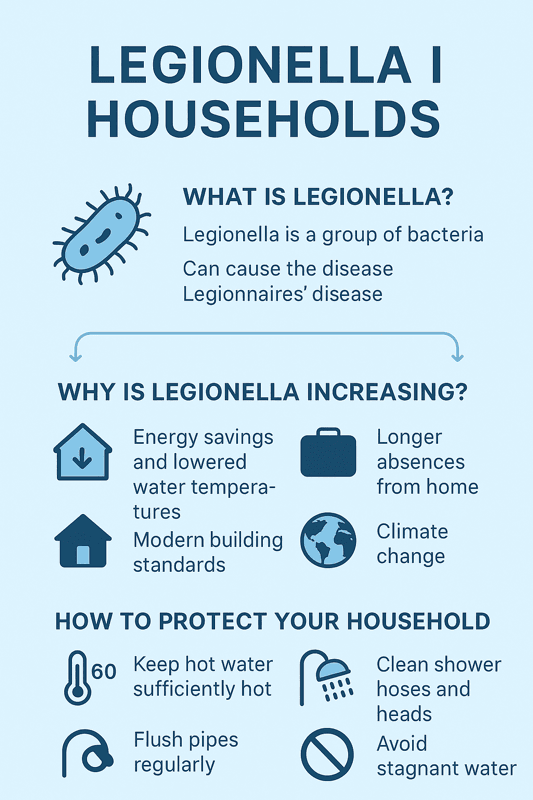Legionella is a bacterium that has long been a known problem in hospitals, nursing homes, and larger buildings. But recently, we are also seeing ordinary households in Sweden being affected more frequently. The question is why – and how can you, as a homeowner or resident, protect yourself? In this article, we’ll explain what legionella is, why it is increasing now, the risks it poses, and concrete tips for preventing its spread at home.
What is legionella?
Legionella is a group of bacteria naturally found in lakes and rivers in very low concentrations. The problem arises when they find the right environment to grow inside our water systems. The most well-known species is Legionella pneumophila, which can cause the disease Legionnaires’ disease.
The bacteria thrive best in stagnant water with temperatures between 20 and 45 degrees Celsius. When the water evaporates and tiny droplets spread in the air – for example from the shower – the bacteria can be inhaled. This may cause a lung infection.
Why is legionella increasing in Swedish households?
In recent years, reported cases of legionella have risen in Sweden. Several factors contribute to this trend:
1. Energy savings and lowered water temperatures
Many households and housing associations lower the water heater temperature to reduce electricity costs. Unfortunately, this often means the temperature drops below 60 degrees Celsius, creating favorable conditions for legionella growth.
2. Longer absences from home
Vacations, remote work in other locations, or long trips mean water may sit still in pipes. Stagnant water increases bacterial growth risks.
3. Modern building standards
New energy-efficient houses and plumbing installations with longer pipe runs can create larger volumes of standing water.
4. Climate change
Rising average temperatures in the environment also make it easier for bacteria to survive and grow.
What symptoms does legionella cause?
Legionella can cause two different illnesses:
- Legionnaires’ disease: a severe pneumonia with symptoms such as high fever, cough, chills, and breathing difficulties. Always requires hospital care and antibiotics.
- Pontiac fever: a milder flu-like illness that resolves on its own within a few days.
Elderly people, smokers, and individuals with weakened immune systems are most at risk.
How does legionella spread in the home?
In households, the most common sources of infection are:
- Shower hoses and shower heads
- Hot tubs and spas
- Humidifiers
- Dishwashers running on low temperatures
- Water heaters not maintaining sufficient heat
It is important to remember that the bacteria do not spread from person to person. The risk only arises when contaminated water becomes aerosolized and is inhaled.
How to protect your household against legionella
There are several simple but effective measures to reduce the risk of legionella:
Keep hot water sufficiently hot
- Ensure your water heater always holds at least 60 degrees Celsius.
- Tap water (at the faucet or shower) should reach at least 50 degrees Celsius.
Flush pipes regularly
- Run water for a few minutes in showers and taps that haven’t been used for a while.
- After vacations or long absences: flush the entire system before use.
Clean shower hoses and heads
- Descale regularly, as lime deposits provide an environment for bacteria to thrive.
- Replace shower hoses when necessary.
Avoid stagnant water
- When installing new water heaters or plumbing – avoid “dead ends” where water can remain stagnant.
FAQ – Frequently asked questions
Yes, but most cases are only noticed when someone becomes ill. Cases are rising, and health authorities are monitoring the trend.
No, the bacteria spread by inhalation of droplets – not by ingestion.
Legionnaires’ disease can be deadly if not treated in time, especially for older people and those with weakened immune systems.
Water samples can be taken by accredited laboratories. If you suspect a problem, contact a plumber or environmental consultant.
Authorities’ recommendations
The Swedish Public Health Agency and the National Board of Housing, Building and Planning recommend that property owners ensure hot water systems always maintain the correct temperature. There are also legal requirements for buildings that serve many residents, such as hotels, nursing homes, and rental properties. But individual households can also be affected – and in those cases, responsibility lies with the homeowner.
Conclusion
Legionella is a bacterium that has always existed in our water but is now becoming a growing concern in households. The combination of energy-saving measures, modern building practices, and climate change increases the risk. By following simple routines – maintaining the right temperature, flushing water systems, and regular cleaning – you can minimize the chance of bacteria taking hold in your home.
Awareness and prevention are the best protection.
